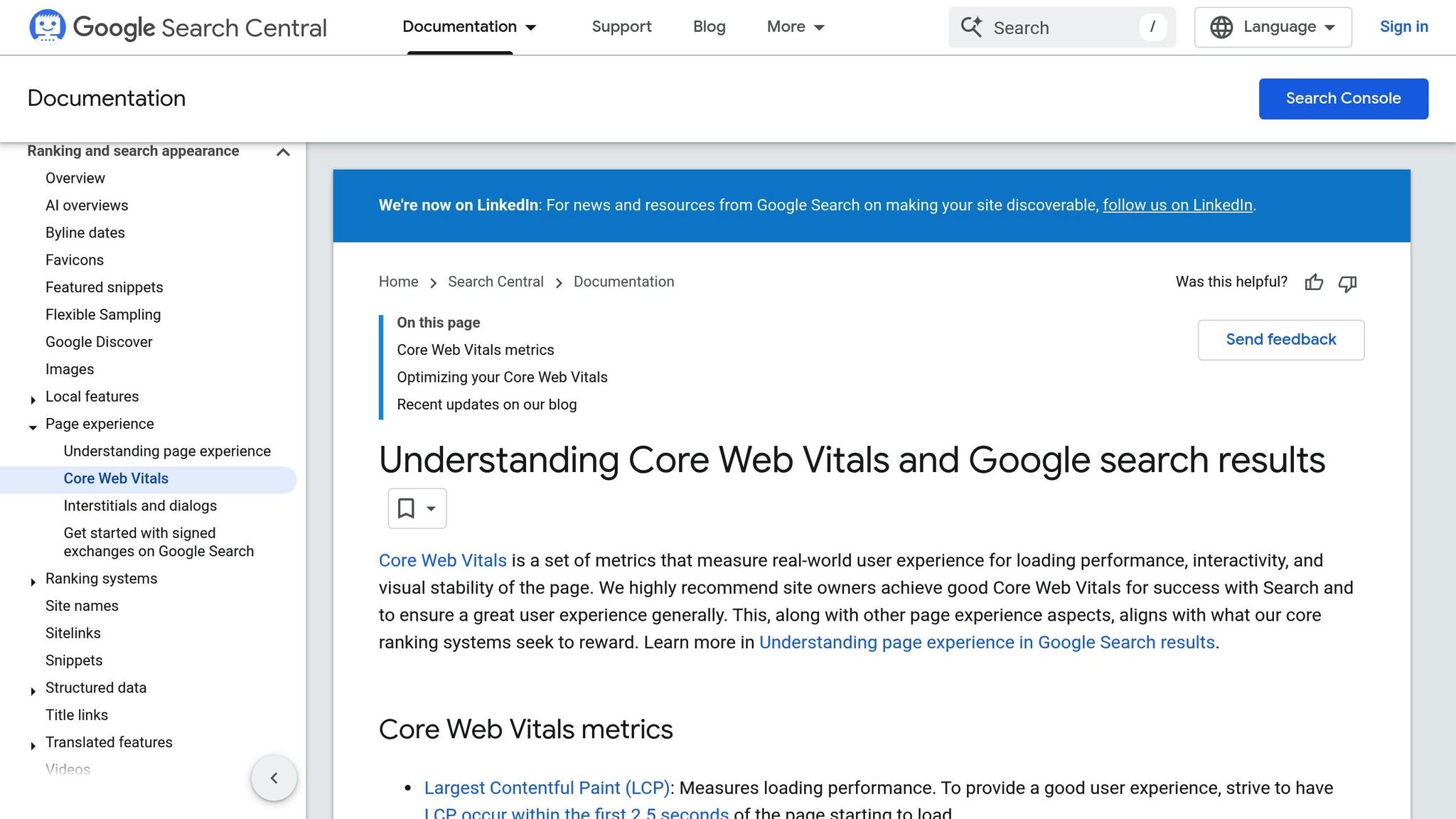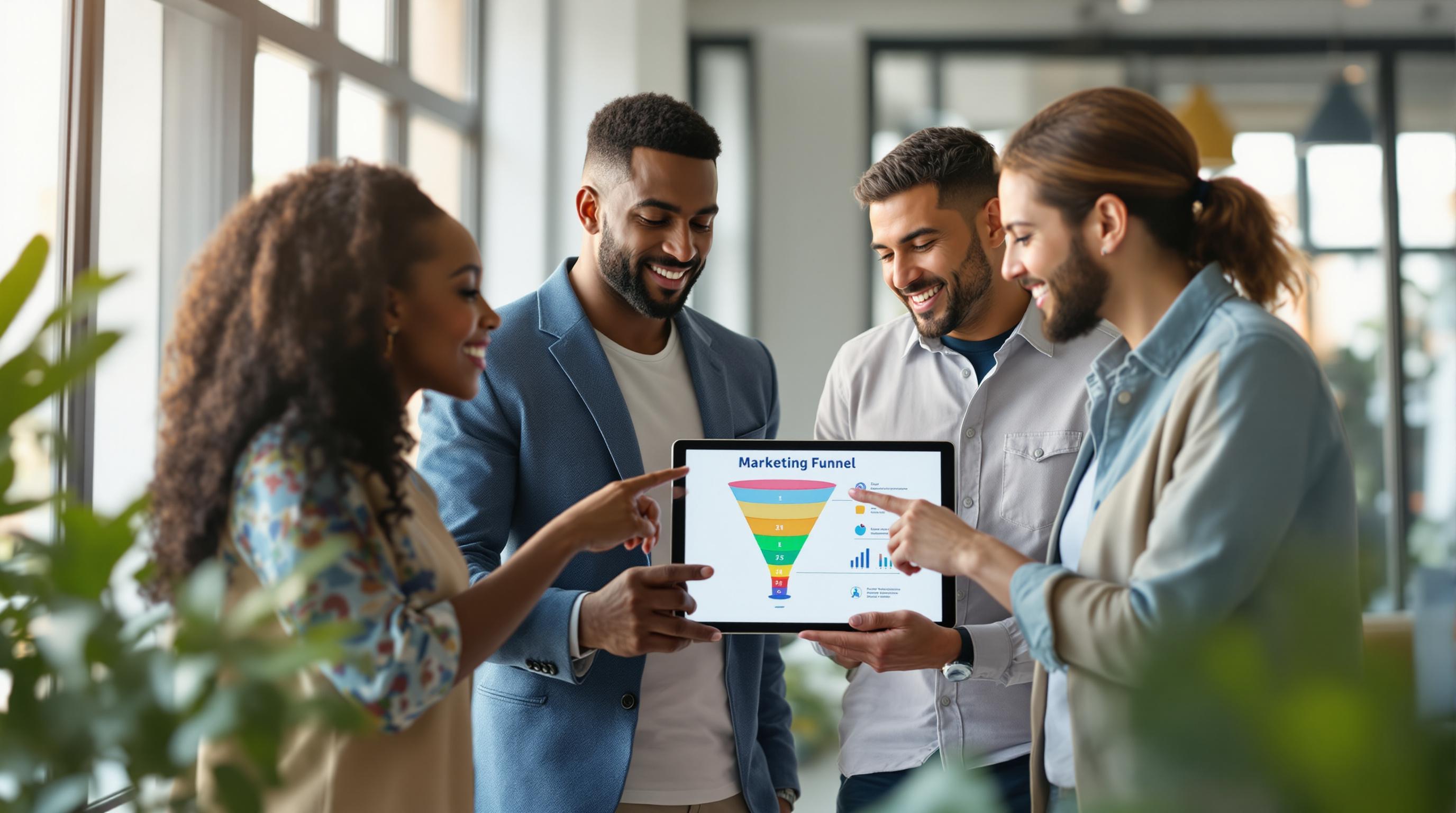Good UX is critical for better SEO. Here's why: search engines like Google evaluate not just your content but also how users interact with your website. Poor UX - like slow load times, confusing navigation, or mobile issues - can lead to higher bounce rates and lower rankings.
Key Ways UX Impacts SEO at Each Funnel Stage:
- Awareness: Slow pages, poor mobile design, and intrusive pop-ups push visitors away.
- Consideration: Confusing site structure and hard-to-navigate content frustrate users.
- Conversion: Broken forms, slow checkouts, and missing trust signals hurt conversions.
Metrics Affected:
- Bounce Rate: High bounce rates signal bad UX to search engines.
- Core Web Vitals: Metrics like load speed (LCP), interactivity (FID), and layout stability (CLS) directly affect rankings.
Quick Tips to Fix UX Problems:
- Speed Up Pages: Compress images, enable caching, and minimize code.
- Improve Navigation: Use clear menus, breadcrumbs, and search bars.
- Optimize for Mobile: Ensure responsive design and easy-to-click buttons.
- Simplify Conversions: Reduce form fields, fix technical glitches, and use SSL for security.
Better UX means happier users - and better SEO rankings. Start optimizing today!
How to Improve SEO With User Experience Factors
Common UX Problems That Hurt SEO
Poor user experience can directly affect how search engines rank your website. Let’s break down specific UX problems at each stage of the funnel that can negatively impact your SEO performance.
Awareness Stage Issues
First impressions matter, especially at the awareness stage. Technical issues here can immediately turn potential visitors away:
- Slow Page Load Times: Visitors expect pages to load quickly. Slow speeds lead to higher bounce rates and frustrated users.
- Poor Mobile Responsiveness: Non-responsive designs force users to pinch, zoom, or scroll horizontally, creating a frustrating experience and sending negative usability signals.
- Intrusive Interstitials: Pop-ups that block content, especially on mobile, disrupt the user experience and can even violate search engine guidelines.
These problems often set the stage for more challenges as users move through the funnel.
Consideration Stage Issues
At this stage, how well your site organizes content and facilitates navigation becomes critical:
- Confusing Site Architecture: If users can't find what they’re looking for quickly, they’ll leave. Clear navigation and logical content grouping are key.
- Poor Internal Search: Weak search tools that lack auto-suggestions, return irrelevant results, or can't handle misspellings frustrate visitors and hurt engagement.
- Weak Content Structure: Long blocks of text without headings, bullet points, or visual elements make content harder to scan and less engaging.
When users struggle to navigate or understand your content, it’s much harder to move them toward conversion.
Conversion Stage Issues
UX problems at the conversion stage can directly impact your business goals:
- Complex Forms: Forms with too many fields or unclear instructions reduce conversions. Common issues include unnecessary required fields, vague error messages, and forms that aren’t mobile-friendly.
- Broken Trust Elements: Missing SSL certificates, trust badges, or visible security indicators can erode user confidence, leading to abandoned carts.
- Technical Glitches: Problems like slow payment processing, unclear error messages, or session timeouts during checkout discourage users from completing their transactions.
These issues don’t just hurt user behavior in the moment - they also send search engines signals about your site's quality and relevance, which can ultimately harm your rankings.
Key SEO Metrics Affected by UX
The UX challenges mentioned earlier have a direct, measurable impact on your site's SEO performance.
User Engagement Metrics
Your site's UX plays a big role in shaping engagement metrics like bounce rate, session duration, and pages per session. These numbers tell you how well your site satisfies user needs at different stages of their journey.
When UX issues arise, here's what happens:
- High bounce rates: This often points to content that doesn't align with what users are looking for.
- Short session durations: May indicate accessibility problems or a lack of engaging content.
- Low pages per session: Often a sign of poor navigation or unclear paths for users.
Mobile and Core Web Vitals

Mobile experience and Core Web Vitals are key factors in search rankings:
Largest Contentful Paint (LCP)
- Should load in under 2.5 seconds.
- Slow load times drive users away and hurt both mobile and desktop rankings.
First Input Delay (FID)
- Must be under 100 milliseconds.
- Ensures interactive elements respond quickly.
Cumulative Layout Shift (CLS)
- Needs to stay under 0.1.
- Prevents frustrating visual shifts, especially on mobile.
These metrics signal your site's overall quality to search engines.
Technical SEO Factors
Site Architecture and Crawlability
- Complicated URLs make it harder for search engines to crawl your site efficiently.
- Weak internal linking can limit the discovery of important pages.
- Poor navigation increases the risk of duplicate content.
Page Structure and Content Access
- Content hidden in tabs or accordions may carry less SEO weight.
- Incorrect JavaScript setup can block search engines from indexing key pages.
- A messy heading structure makes it harder for search engines to understand content priorities.
Site Performance
- Slow server responses and unoptimized resources hurt both crawl efficiency and page load times.
- Mobile-first indexing requires a responsive design to meet modern search engine standards.
sbb-itb-a84ebc4
Fixing UX Issues to Improve SEO
Here’s how to tackle UX challenges to boost both user experience and SEO across different stages of the funnel.
Awareness Stage Fixes
First impressions matter. Make sure your site leaves a positive impact on new visitors by addressing these areas:
Speed Improvements
- Convert images to WebP format for faster loading.
- Use lazy loading for content below the fold.
- Minify CSS, JavaScript, and HTML files.
- Enable browser caching to speed up repeat visits.
Better Navigation
- Use clear, descriptive labels for menus.
- Add breadcrumbs to help users stay oriented.
- Place a search bar where it’s easy to find.
- Space out menu items to make them easier to tap on mobile devices.
Mobile Optimization
- Set viewport meta tags to ensure proper scaling.
- Implement responsive images for different screen sizes.
- Ensure text is legible without needing to zoom.
- Adjust touch targets to make them easy to click.
Once these elements are in place, shift your focus to addressing barriers in the conversion stage.
Conversion Stage Fixes
Simplify the conversion process to encourage users to take action while supporting SEO efforts:
Improving the Checkout Process
- Minimize the number of fields users need to fill out.
- Add progress indicators to show how far along they are.
- Allow guest checkout to reduce friction.
- Offer a variety of payment options.
Technical Adjustments
- Fix any broken links and address 404 errors.
- Set up proper redirects to avoid dead ends.
- Optimize thank-you pages for user engagement.
- Ensure your site is secured with an SSL certificate.
Conclusion: Better UX Leads to Better SEO
Improving user experience (UX) directly impacts search rankings by signaling your site's value to search engines. When your site offers a smooth and satisfying experience, it reinforces its relevance and quality.
How UX Supports SEO:
Focusing on UX improvements can help businesses see better results in key areas:
- Lower bounce rates
- Longer session durations
- Higher conversion rates
- Better mobile usability
Interactive elements, like AI-powered chatbots, can increase engagement and keep visitors on your site longer, both of which support SEO efforts.
For businesses looking to take their marketing funnels to the next level, the Marketing Funnels Directory provides a range of tools and courses. These resources are designed to help enhance both UX and SEO, making it easier to implement the strategies discussed here.
Finally, remember that UX optimization isn’t a one-time task. Regular testing and updates ensure your site stays aligned with user expectations and search engine requirements. A smooth and user-friendly experience at every stage of the funnel strengthens your site's SEO foundation and guides users from awareness to conversion effectively.
FAQs
How does improving user experience (UX) during the awareness stage impact my website's SEO?
Enhancing user experience (UX) at the awareness stage can significantly boost your website's SEO by improving how users interact with your content early in their journey. A seamless, engaging experience encourages visitors to stay longer, reducing bounce rates and signaling to search engines that your site provides value.
Key factors include fast page load times, mobile-friendly design, and intuitive navigation. These elements not only keep users engaged but also align with search engine algorithms that prioritize user satisfaction. By addressing UX issues during this stage, you can build trust with your audience while improving your site's search rankings.
How can I improve mobile UX to boost my site's SEO performance?
Optimizing mobile user experience (UX) is essential for improving your site's search engine rankings, as search engines prioritize mobile-friendly websites. To enhance mobile UX, focus on these key strategies:
- Ensure fast loading times: Compress images, minimize code, and use caching to reduce page load times.
- Implement responsive design: Make sure your site adapts seamlessly to different screen sizes and orientations.
- Simplify navigation: Use clear menus and intuitive layouts to help users find information quickly.
- Optimize touch elements: Ensure buttons and links are easy to tap without accidental clicks.
By prioritizing these elements, you'll not only improve the user experience but also enhance your site's visibility and performance in search engine results.
How can I identify and prioritize UX issues to improve SEO performance at different funnel stages?
To identify and prioritize UX issues that impact SEO, start by analyzing user behavior across the marketing funnel. Use tools like Google Analytics or heatmaps to pinpoint where users drop off or encounter friction. Focus on key metrics such as bounce rates, time on page, and conversion rates to identify problem areas.
Once you've identified issues, prioritize them based on their potential impact. For example, fixing slow page load times or improving mobile responsiveness can have an immediate and significant effect on both user experience and search rankings. Addressing these high-priority issues first ensures you see the greatest improvements in SEO performance across all stages of the funnel.


